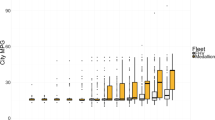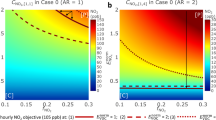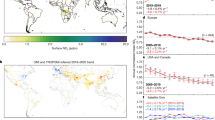Abstract
Many European countries do not meet legal air quality standards for ambient nitrogen dioxide (NO2) near roads; a problem that has been forecasted to persist to 2030. Although European air quality standards regulate NO2 concentrations, emissions standards for new vehicles instead set limits for NO x —the combination of nitric oxide (NO) and NO2. From around 1990 onwards, the total emissions of NO x declined significantly in Europe, but roadside concentrations of NO2—a regulated species—declined much less than expected. This discrepancy has been attributed largely to the increasing usage of diesel vehicles in Europe and more directly emitted tailpipe NO2. Here we apply a data-filtering technique to 130 million hourly measurements of NO x , NO2 and ozone (O3) from roadside monitoring stations across 61 urban areas in Europe over the period 1990–2015 to estimate the continent-wide trends of directly emitted NO2. We find that the ratio of NO2 to NO x emissions increased from 1995 to around 2010 but has since stabilized at a level that is substantially lower than is assumed in some key emissions inventories. The proportion of NO x now being emitted directly from road transport as NO2 is up to a factor of two smaller than the estimates used in policy projections. We therefore conclude that there may be a faster attainment of roadside NO2 air quality standards across Europe than is currently expected.
This is a preview of subscription content, access via your institution
Access options
Access Nature and 54 other Nature Portfolio journals
Get Nature+, our best-value online-access subscription
$29.99 / 30 days
cancel any time
Subscribe to this journal
Receive 12 print issues and online access
$259.00 per year
only $21.58 per issue
Buy this article
- Purchase on Springer Link
- Instant access to full article PDF
Prices may be subject to local taxes which are calculated during checkout




Similar content being viewed by others
References
Cames, M. & Helmers, E. Critical evaluation of the European diesel car boom — global comparison, environmental effects and various national strategies. Environ. Sci. Eur. 25, 1–22 (2013).
Dieselisation in the EEA (European Environment Agency, 2015); http://www.eea.europa.eu/data-and-maps/figures/dieselisation-in-the-eea
European Vehicle Market Statistics, 2015/2016 (International Council on Clean Transportation Europe, 2015); http://www.theicct.org/european-vehicle-market-statistics-2015-2016
Share of Diesel in New Passenger Cars (European Automobile Manufacturers’ Association, 2016); http://www.acea.be/statistics/tag/category/share-of-diesel-in-new-passenger-cars.
Koetse, M. J. & Hoen, A. Preferences for alternative fuel vehicles of company car drivers. Resour. Energy Econ. 37, 279–301 (2014).
ACEA Tax Guide (European Automobile Manufacturers’ Association, 2016).
Schmidt, C. W. Beyond a one-time scandal: Europe’s onging diesel pollution problem. Environ. Health Perspect. 124, A19–A22 (2016).
Weiss, M. et al. Will Euro 6 reduce the NO x emissions of new diesel cars? Insights from on-road tests with Portable Emissions Measurement Systems (PEMS). Atmos. Environ. 62, 657–665 (2012).
Directive 2008/50/EC of the European Parliament and of the Council of 21 May 2008 on Ambient Air Quality and Cleaner Air for Europe (European Parliament and Council, 2008); http://data.europa.eu/eli/dir/2008/50/oj
Air Quality in Europe—2016 Report Report. No 28/2016. (European Environment Agency, 2016); http://www.eea.europa.eu/publications/air-quality-in-europe-2016
Carslaw, D. C. & Carslaw, N. Detecting and characterising small changes in urban nitrogen dioxide concentrations. Atmos. Environ. 41, 4723–4733 (2007).
Alvarez, R., Weilenmann, M. & Favez, J.-Y. Evidence of increased mass fraction of NO2 within real-world NO x emissions of modern light vehicles—derived from a reliable online measuring method. Atmos. Environ. 42, 4699–4707 (2008).
Keuken, M., Roemer, M. & van den Elshout, S. Trend analysis of urban NO2 concentrations and the importance of direct NO2 emissions versus ozone/NO x equilibrium. Atmos. Environ. 43, 4780–4783 (2009).
Williams, M. L. & Carslaw, D. C. New directions: science and policy—out of step on NO x and NO2? Atmos. Environ. 45, 3911–3912 (2011).
Kiesewetter, G. et al. Modelling NO2 concentrations at the street level in the GAINS integrated assessment model: projections under current legislation. Atmos. Chem. Phys. 14, 813–829 (2014).
Carslaw, D. C., Murrells, T. P., Andersson, J. & Keenan, M. Have vehicle emissions of primary NO2 peaked? Faraday Discus. 189, 439–454 (2016).
Carslaw, D. C. Evidence of an increasing NO2/NO x emissions ratio from road traffic emissions. Atmos. Environ. 39, 4793–4802 (2005).
N. E. Ligterink, G. Kadijk, & P. van Mensch. Determination of Dutch NO x Emission Factors for Euro-5 Diesel Passenger Cars TNO 2012 R11099 (TNO, 2012).
Carslaw, D. C., Beevers, S. D., Tate, J. E., Westmoreland, E. J. & Williams, M. L. Recent evidence concerning higher NO x emissions from passenger cars and light duty vehicles. Atmos. Environ. 45, 7053–7063 (2011).
WHO Air Quality Guidelines for Europe 2nd edn (World Health Organization, 2000); http://www.euro.who.int/en/health-topics/environment-and-health/air-quality/publications/pre2009/who-air-quality-guidelines-for-europe,-2nd-edition,-2000-cd-rom-version
Premature Deaths Attributable to Air Pollution (European Environment Agency, 2016); https://www.eea.europa.eu/media/newsreleases/many-europeans-still-exposed-to-air-pollution-2015/premature-deaths-attributable-to-air-pollution
European Environment Agency. Exceedances of air quality objectives due to traffic (2016); http://www.eea.europa.eu/data-and-maps/indicators/exceedances-of-air-quality-objectives/exceedances-of-air-quality-objectives-9
Grice, S. et al. Recent trends and projections of primary NO2 emissions in Europe. Atmos. Environ. 43, 2154–2167 (2009).
Brand, C. Beyond ‘Dieselgate’: implications of unaccounted and future air pollutant emissions and energy use for cars in the United Kingdom. Energy Policy 97, 1–12 (2016).
Ntziachristos, L., Papadimitriou, G., Ligterink, N. & Hausberger, S. Implications of diesel emissions control failures to emission factors and road transport NO x evolution. Atmos. Environ. 141, 542–551 (2016).
Gkatzoflias, D., Kouridis, C., Ntziachristos, L. & Samaras, Z. COPERT 4. Computer programme to calculate emissions from road transport—User manual (version 9.0) (2012).
Handbook Emission Factors for Road Transport (HBEFA) Version 3.3 (INFRAS, 2017); http://www.hbefa.net/e/index.html
Vehicle Emissions Testing Programme (Department for Transport, 2016); https://www.gov.uk/government/uploads/system/uploads/attachment_data/file/548148/vehicle-emissions-testing-programme-web.pdf
Johnson, T. V. Review of diesel emissions and control. SAE Int. J. Fuels Lubr. 3, 16–29 (2010).
Wild, R. J. et al. On-road measurements of vehicle NO2/NO x emission ratios in Denver, Colorado, USA. Atmos. Environ. 148, 182–189 (2017).
Transport Emissions—Air Pollutants from Road Transport (European Commission, 2016); http://ec.europa.eu/environment/air/transport/road.htm
Carslaw, D. C. & Rhys Tyler, G. New insights from comprehensive on-road measurements of NO x , NO2 and NH3 from vehicle emission remote sensing in London, UK. Atmos. Environ. 81, 339–347 (2013).
Carslaw, D. C., Williams, M. L., Tate, J. E. & Beevers, S. D. The importance of high vehicle power for passenger car emissions. Atmos. Environ. 68, 8–16 (2013).
Primary NO 2 Emission Factors for Road Vehicles: August 2014 Update (UK National Atmospheric Emission Inventory, 2014).
AirBase–The European Air Quality Database Version 8 (European Environment Agency, 2014); http://www.eea.europa.eu/data-and-maps/data/airbase-the-european-air-quality-database-8
Eionet Central Data Repository (European Environment Agency, 2016); http://cdr.eionet.europa.eu/
Grange S. K. smonitor: A Framework and a Collection of Functions to Allow for Maintenance of Air Quality Monitoring Data (2016); https://github.com/skgrange/smonitor
Carslaw, D. C. & Ropkins, K. openair—An R package for air quality data analysis. Environ. Model. Softw. 27–28, 52–61 (2012).
Carslaw D. & Ropkins. K. o penair: Open-source Tools for the Analysis of Air Pollution Data (2015).
Association de Surveillance de la Qualité de l’Air en Île-de-France (Airparif, 2016); http://www.airparif.asso.fr
Grange, S. K. Technical Note: smonitor Europe version 1.0.1 (Wolfson Atmospheric Chemistry Laboratories, University of York, 2017).
R Core Team R: A Language and Environment for Statistical Computing (R Foundation for Statistical Computing, 2016); https://www.R-project.org
PostgreSQL Version 9.5 (PostgreSQL Global Development Group, 2016; https://www.postgresql.org
Parrish, D. D. et al. Decadal change in carbon monoxide to nitrogen oxide ratio in U.S. vehicular emissions. J. Geophys. Res. 107, 5–9 (2002). ACH 5-1–ACH.
Hassler, B. et al. Analysis of long-term observations of NOx and CO in megacities and application to constraining emissions inventories. Geophys. Res. Lett. 43, 9920–9930 (2016).
European Cities—the EU–OECD Functional Urban Area Definition (European Commission, 2015); http://ec.europa.eu/eurostat/statistics-explained/index.php/European_cities_%E2%80%93_the_EU-OECD_functional_urban_area_definition
OpenStreetMap Foundation and OpenStreetMap contributors OpenStreetMap (OpenStreetMap Foundation, 2016); http://www.openstreetmap.org
Haklay, M. & Weber, P. OpenStreetMap: User-Generated Street Maps. IEEE Pervas. Comput. 7, 12–18 (2008).
Steinbacher, M. et al. Nitrogen oxide measurements at rural sites in switzerland: Bias of conventional measurement techniques. J. Geophys. Res. 112, 13 (2007).
Kirchstetter, T. W., Harley, R. A. & Littlejohn, D. Measurement of nitrous acid in motor vehicle exhaust. Environ. Sci. Technol. 30, 2843–2849 (1996).
Venables, W. N. & Ripley, B. D. Modern Applied Statistics with S. 4th edn (Springer, New York, 2002).
Muggeo, V. M. Estimating regression models with unknown break-points. Stat. Med. 22, 3055–3071 (2003).
Muggeo, V. M. Segmented: an R package to fit regression models with broken-line relationships. R News 8, 20–25 (2008).
Jenkin, M. E. Analysis of sources and partitioning of oxidant in the UK—Part 2: contributions of nitrogen dioxide emissions and background ozone at a kerbside location in London. Atmos. Environ. 38, 5131–5138 (2004).
Acknowledgements
The authors thank A. Wild for the provision of the Wild Fund Scholarship. This work was also partially funded by the 2016 Natural Environment Research Council (NERC) air quality studentships programme (Grant no. NE/N007115/1). A.C.L. is supported by the NCAS national capability programme and S.J.M. acknowledges the receipt of a NERC KE Fellowship. C. Stovell and his team are thanked for setting-up and maintaining a PostgreSQL database server.
Author information
Authors and Affiliations
Contributions
D.C.C. designed the research questions, and with S.K.G. developed and evaluated the appropriate methods. S.K.G. processed the European air quality data and conducted the data analysis with D.C.C. S.K.G., D.C.C., A.C.L. and S.J.M. wrote the paper.
Corresponding author
Ethics declarations
Competing interests
The authors declare no competing financial interests.
Additional information
Publisher’s note: Springer Nature remains neutral with regard to jurisdictional claims in published maps and institutional affiliations.
Suplementary information
Suplementary Information
Supplementary Tables 1–2; Supplementary Figures 1–3
Supplementary Data
Supplementary Table 3
Rights and permissions
About this article
Cite this article
Grange, S.K., Lewis, A.C., Moller, S.J. et al. Lower vehicular primary emissions of NO2 in Europe than assumed in policy projections. Nature Geosci 10, 914–918 (2017). https://doi.org/10.1038/s41561-017-0009-0
Received:
Accepted:
Published:
Issue Date:
DOI: https://doi.org/10.1038/s41561-017-0009-0
This article is cited by
-
Photocatalytic-treated asphalt road in Copenhagen for urban \(\text{NO}_{x}\) removal
Clean Technologies and Environmental Policy (2023)
-
Asthma and COPD exacerbation in relation to outdoor air pollution in the metropolitan area of Berlin, Germany
Respiratory Research (2022)
-
Research on a China 6b heavy-duty diesel vehicle real-world engine out NOx emission deterioration and ambient correction using big data approach
Environmental Science and Pollution Research (2022)
-
Spatiotemporal variability of nitrogen dioxide (NO2) pollution in Manchester (UK) city centre (2017–2018) using a fine spatial scale single-NOx diffusion tube network
Environmental Geochemistry and Health (2022)
-
Re-evaluating effectiveness of vehicle emission control programmes targeting high-emitters
Nature Sustainability (2020)



